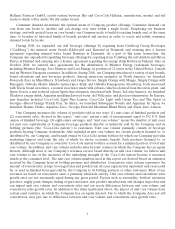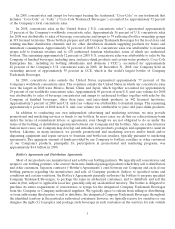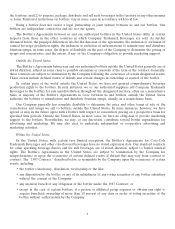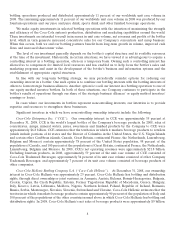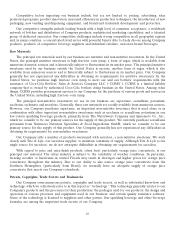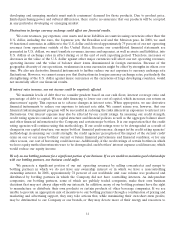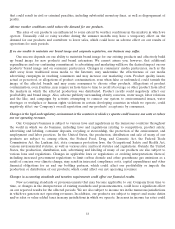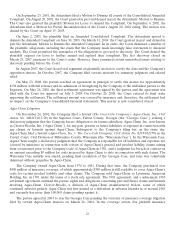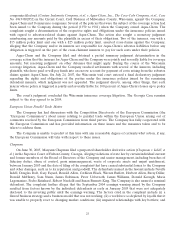Coca Cola 2008 Annual Report Download - page 15
Download and view the complete annual report
Please find page 15 of the 2008 Coca Cola annual report below. You can navigate through the pages in the report by either clicking on the pages listed below, or by using the keyword search tool below to find specific information within the annual report.Changes in the nonalcoholic beverages business environment could impact our financial results.
The nonalcoholic beverages business environment is rapidly evolving as a result of, among other things,
changes in consumer preferences, including changes based on health and nutrition considerations and obesity
concerns; shifting consumer tastes and needs; changes in consumer lifestyles; and competitive product and
pricing pressures. In addition, the industry is being affected by the trend toward consolidation in the retail
channel, particularly in Europe and the United States. If we are unable to successfully adapt to this rapidly
changing environment, our net income, share of sales and volume growth could be negatively affected.
The global credit crisis may adversely affect our liquidity and financial performance.
The global credit markets have experienced unprecedented disruptions in recent months. If the current
credit crisis were to worsen, we may be unable to access credit markets on favorable terms, which could increase
our cost of borrowing. In addition, the current credit crisis may make it more difficult for our bottling partners to
access financing on terms comparable to those obtained historically, which would affect the Coca-Cola system’s
profitability as well as our share of the income of bottling partners in which we have equity method investments.
The current global credit market conditions and their actual or perceived effects on our and our major bottling
partners’ results of operations and financial condition, along with the deteriorating economic environment
brought about by the financial crisis, may increase the likelihood that the major independent credit agencies will
downgrade our credit ratings, which could have a negative effect on our borrowing costs. The significant decline
in the equity markets and in the valuation of other assets precipitated by the credit crisis and financial system
instability has affected the value of our pension plan assets. The lower pension plan asset base will negatively
affect our return on plan assets and thus increase our pension expense. In addition, if the current adverse market
conditions continue for a prolonged period of time or deteriorate further, it could have an additional negative
impact on our future pension benefit expense. As a result of the decline in the fair value of our pension plans
assets and a decrease in the discount rate used to calculate pension benefit obligations, we have made and will
consider making additional contributions to our U.S. and international pension plans in 2009. In addition, the
instability of major financial institutions caused by the credit crisis could increase the counterparty risk
associated with our existing derivative financial instruments and may increase the cost of, or may impair our
ability to secure credit-worthy counterparties for, future derivative transactions. The decrease in availability of
consumer credit resulting from the financial crisis, as well as general unfavorable economic conditions, may also
cause consumers to reduce their discretionary spending, which would reduce the demand for our beverages and
negatively affect our net revenues and the Coca-Cola system’s profitability.
Increased competition could hurt our business.
The nonalcoholic beverages segment of the commercial beverages industry is highly competitive. We
compete with major international beverage companies that, like our Company, operate in multiple geographic
areas, as well as numerous firms that are primarily local in operation. In many countries in which we do business,
including the United States, PepsiCo, Inc. is a primary competitor. Other significant competitors include, but are
not limited to, Nestl´
e, Dr Pepper Snapple Group, Inc., Groupe Danone, Kraft Foods Inc. and Unilever. In
addition, in certain markets, our competition includes major beer companies. Our ability to gain or maintain
share of sales or gross margins in the global market or in various local markets may be limited as a result of
actions by competitors.
If we are unable to expand our operations in developing and emerging markets, our growth rate could be negatively
affected.
Our success depends in part on our ability to grow our business in developing and emerging markets, which
in turn depends on economic and political conditions in those markets and on our ability to acquire or form
strategic business alliances with local bottlers and to make necessary infrastructure enhancements to production
facilities, distribution networks, sales equipment and technology. Moreover, the supply of our products in
13



